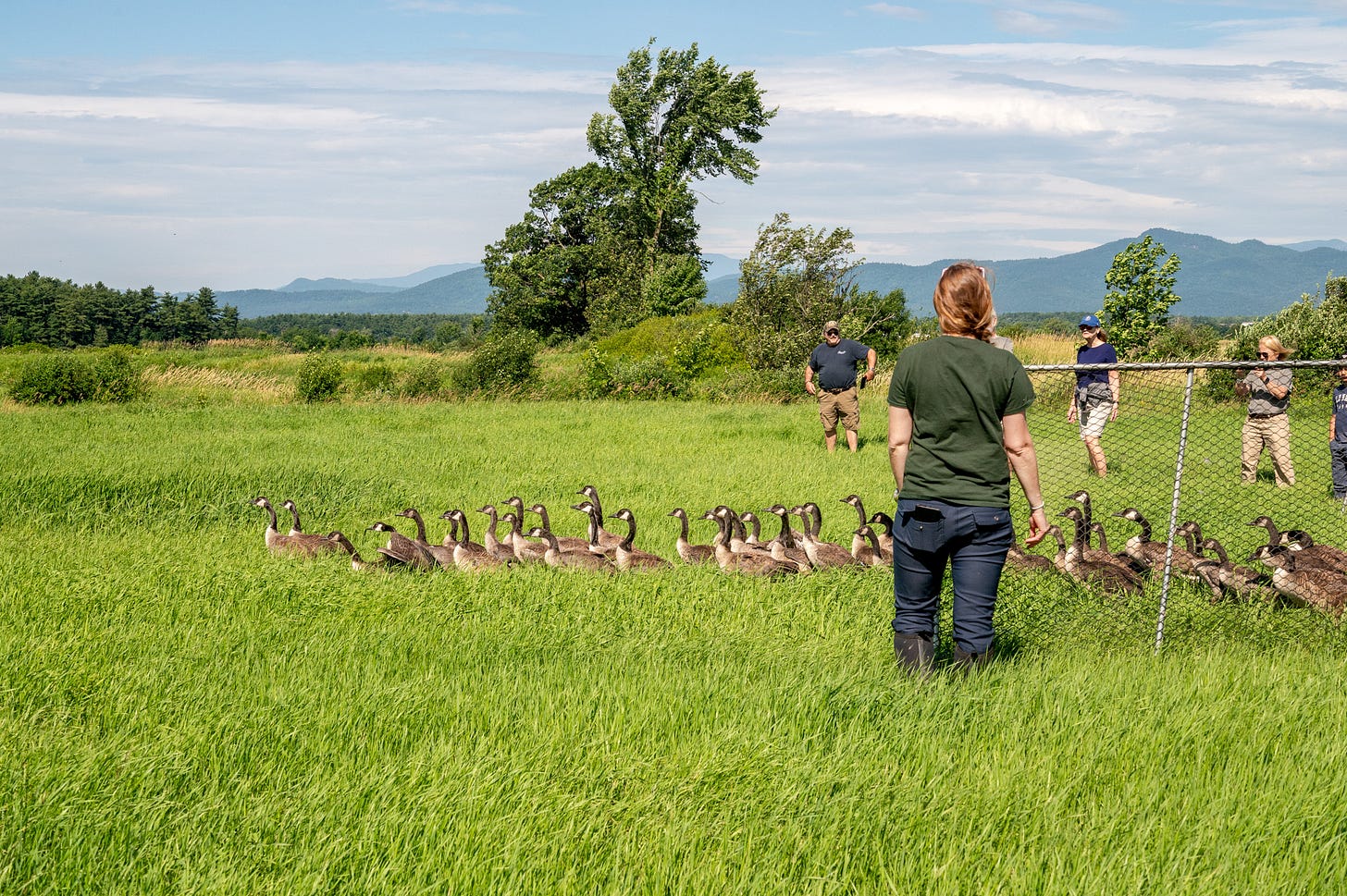Vermont Seeks Volunteers for Goose Banding: But How Do They Catch Them?
Vermonters might wonder, how exactly do you catch a goose—and why don’t they just fly away?
If you’ve ever dreamed of getting up close with wildlife while contributing to conservation, the Vermont Fish and Wildlife Department has an opportunity for you. On Wednesday, July 2, 2025, at 8:00 a.m., the department is calling for 30 to 70 volunteers to help band Canada geese at the Dead Creek Wildlife Management Area off Route 17 in Addison. But as locals and curious Vermonters might wonder, how exactly do you catch a goose—and why don’t they just fly away?
The annual goose banding event is a hands-on effort to monitor Vermont’s resident Canada goose population, a conservation success story that began at Dead Creek in the 1950s. By attaching lightweight, numbered metal bands to the geese’s legs, biologists gather critical data on population trends, migration patterns, and survival rates. “We’re hoping for a strong turnout to make this year’s banding a success,” said Andrew Bouton, state waterfowl biologist. “It’s a unique chance to connect with nature and support wildlife management.”
Herding Flightless Geese: The Technique Unveiled
So, how do volunteers catch these iconic birds? The secret lies in timing and teamwork. The event is scheduled during early July, when adult Canada geese are in the middle of their annual molting period—a 3- to 4-week window when they shed and regrow their flight feathers, rendering them temporarily flightless. Goslings, born earlier in the summer, are also unable to fly, as their feathers are still developing. This natural quirk makes it the perfect time to round up the birds.
Volunteers, guided by Fish and Wildlife staff, work together to gently herd the geese into nets or temporary enclosures, often set up in the marshes and fields of Dead Creek. Picture a coordinated effort where teams form a human barrier, slowly guiding the waddling geese toward a designated capture area. “It’s like a carefully choreographed dance,” Bouton explained. “With enough volunteers, we can efficiently guide the geese without causing them stress.”
Once captured, each goose is carefully handled for just a few minutes. Biologists attach a band, record data like age, sex, and weight, and release the bird back into the wild. The process is quick to minimize stress, and the bands are designed to be lightweight, ensuring they don’t interfere with the geese’s movement or flight once their feathers regrow.
Why Don’t They Fly Away?
The question on everyone’s mind: why don’t the geese just take off? The answer is simple biology. During the molting season, adult geese are grounded, and their young haven’t yet gained the ability to fly. This flightless window, typically lasting 30 to 45 days, is a critical factor in the banding process. “We time the event to work with the geese’s natural cycle,” Bouton said. “It’s a safe and effective way to collect data without needing to chase them through the skies.”
This strategic timing also explains why Dead Creek, with its mix of wetlands, fields, and open water, is an ideal location. The area attracts large numbers of molting geese, making it easier to band a representative sample of the population in a single morning.
What to Expect as a Volunteer
Volunteers should come prepared for a morning outdoors, as the event involves walking through uneven terrain with little shade. The department recommends wearing sturdy hiking or rubber boots, bringing plenty of water, and applying sun protection. Children are welcome but must be accompanied by an adult to ensure safe handling of the geese.
The day begins promptly at 8:00 a.m. at the Fish and Wildlife office, located past the Dead Creek Visitor Center. Volunteers will receive a brief orientation before heading into the field. “It’s physical work, but it’s incredibly rewarding,” said Bouton. “You’re not just helping with banding—you’re part of a legacy of goose conservation in Vermont.”
For those worried about the geese’s well-being, rest assured: the process is designed to be gentle. The geese are released immediately after banding, often returning to their families in the same area. The data collected helps biologists track population health, ensuring the species continues to thrive in Vermont’s landscapes.
A Legacy of Conservation
The Canada geese at Dead Creek are a testament to decades of conservation efforts. In the 1950s, the Vermont Fish and Wildlife Department began restoring the population, which had dwindled due to habitat loss and overhunting. Today, the resident geese are a familiar sight, grazing in fields and gliding across ponds. Banding ensures this success story continues by providing insights into population dynamics and informing management decisions.
For Vermonters, the banding event is more than a volunteer opportunity—it’s a chance to engage with a species that’s woven into the state’s natural heritage. Whether you’re a seasoned birder or just curious about wildlife, the experience offers a rare glimpse into the science of conservation.
How to Get Involved
Ready to join the wild goose chase? Contact the Fish and Wildlife office in Essex at 802-878-1564 to sign up. Be sure to leave your phone number in case the event is rescheduled due to bad weather. With a bit of teamwork and a lot of heart, you can help ensure Vermont’s Canada geese soar for generations to come.
As Bouton put it, “It’s not every day you get to hold a goose and contribute to science. Come out and make a difference.”
For more information on Vermont’s wildlife programs, visit the Vermont Fish and Wildlife Department’s website.




